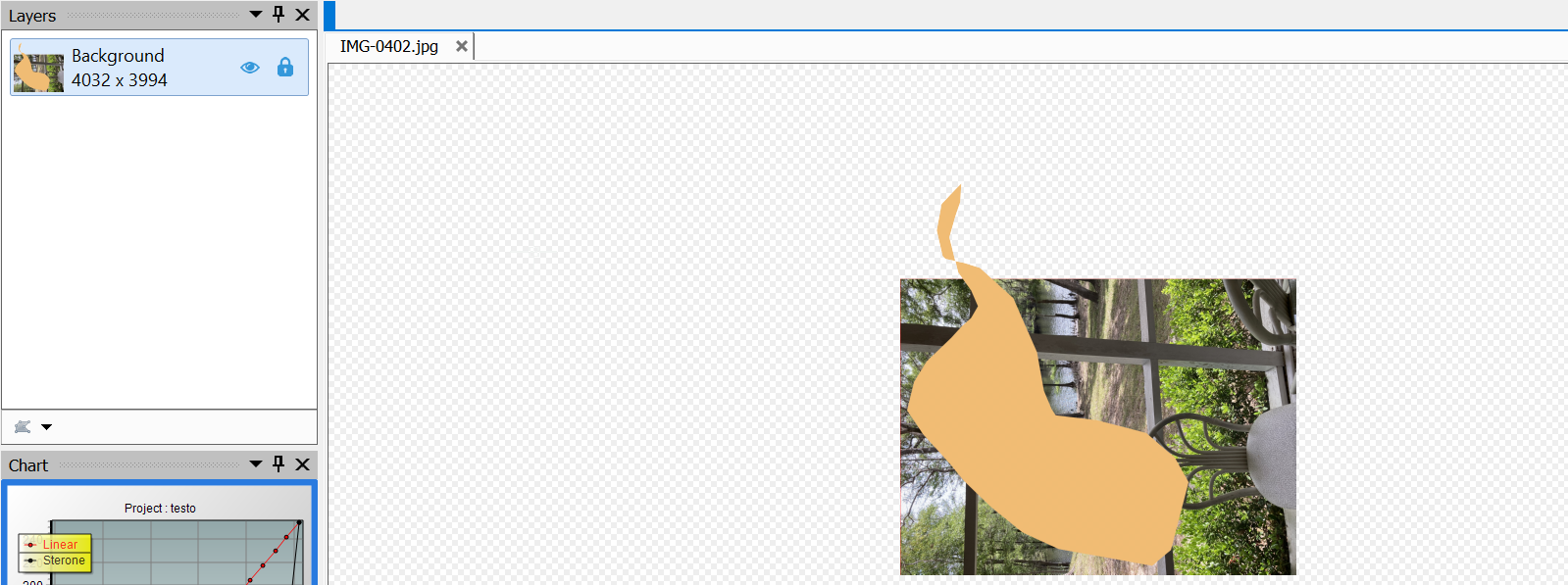| Author |
 Topic Topic  |
|
|
pierrotsc
  
USA
499 Posts |
 Posted - Apr 18 2021 : 13:34:52 Posted - Apr 18 2021 : 13:34:52


|
I think i am trying too hard but cannot figure out this one.
I have a background picture and want to draw a polyline on another layer on top of my background.
I am missing something. every time i draw, it had the polyline on the same layer as the background.
Here's my code.
ActiveImageEnView().MouseInteractGeneral := [];
ActiveImageEnView().LayerOptions := ActiveImageEnView().LayerOptions +
[loAllowMultiSelect, loAutoSelectMask, loShowRotationGrip];
ActiveImageEnView().LayersAdd(TIELayerKind(ielkPolyline));
ActiveImageEnView().LayersAutoClosePolylines := iecmOnNearFinish;
ActiveImageEnView().MouseInteractLayers := [mlMoveLayers, mlEditLayerPoints,
mlRotateLayers, mlResizeLayers, mlDrawCreatePolylineLayers];
ActiveImageEnView().CurrentLayer.FillColor := clNone;
ActiveImageEnView().CurrentLayer.BorderWidth := 3;
ActiveImageEnView().CurrentLayer.BorderColor := clred;
ActiveImageEnView().Update;
Thank you
Pierre |
|
|
xequte
    
39280 Posts |
 Posted - Apr 19 2021 : 00:56:45 Posted - Apr 19 2021 : 00:56:45


|
Hi Pierre
Have you tried the demo:
\Demos\LayerEditing\Layers_Lines\Layers.dpr
Looking at your code you add a blank polyline layer, that is not needed:
ActiveImageEnView().LayersAdd(TIELayerKind(ielkPolyline));
As mlDrawCreatePolylineLayers will automatically create a polyline layer as the user draws.
If you check ActiveImageEnView().LayersCount (or a TImageEnLayerMView to your project), you will see it will increase as each polyline is drawn.
Nigel
Xequte Software
www.imageen.com
|
 |
|
|
pierrotsc
  
USA
499 Posts |
 Posted - Apr 19 2021 : 08:01:01 Posted - Apr 19 2021 : 08:01:01


|
Originally the line
ActiveImageEnView().LayersAdd(TIELayerKind(ielkPolyline));
was commented.
when i draw, the polyline is showing on my background layer in the TImageEnLayerMView window. it does not add another layer.
I will look at the layer demo.
Thanks
Pierre |
 |
|
|
pierrotsc
  
USA
499 Posts |
 Posted - Apr 19 2021 : 11:43:16 Posted - Apr 19 2021 : 11:43:16


|
Just looked at the layer demo. it uses the
ImageEnView1.LayersAdd( TIELayerKind( cmbAddLayer.ItemIndex ));
So when i do that, it works too.
It does not use the mlDrawCreatePolylineLayers
On the newlayer event, it makes an explosion. Not really what i am looking for.
case LayerKind of
ielkPolyline : if mlCreatePolylineLayers in ImageEnView1.MouseInteractLayers then // This ensures we don't fill the points when drawing our own polyline using mlClickCreatePolylineLayer
TIEPolylineLayer( ImageEnView1.CurrentLayer ).SetPoints( iesExplosion, True );
So, for me using :
ActiveImageEnView().MouseInteractLayers := [mlMoveLayers, mlEditLayerPoints,
mlRotateLayers, mlResizeLayers, mlDrawCreatePolylineLayers];
do draw a polyline but not on a new layer.
Best
|
 |
|
|
xequte
    
39280 Posts |
 Posted - Apr 19 2021 : 17:29:06 Posted - Apr 19 2021 : 17:29:06


|
Hi
I think there might be some confusion. mlDrawCreatePolylineLayers cannot "draw" onto an image layer (background is image layer) so a new layer must be being created in this situation.
Did you change LayersCount?
Please add a TImageEnLayerMView, connect it to the TImageEnView and observe what happens when you draw a polyline (a new polyline layer should appear).
Nigel
Xequte Software
www.imageen.com
|
 |
|
|
xequte
    
39280 Posts |
 Posted - Apr 19 2021 : 17:31:27 Posted - Apr 19 2021 : 17:31:27


|
Also, you have looked at the wrong demo. Please look at this one:
\Demos\LayerEditing\Layers_Lines\Layers.dpr
Which shows freehand polyline drawing.
Nigel
Xequte Software
www.imageen.com
|
 |
|
|
pierrotsc
  
USA
499 Posts |
 Posted - Apr 19 2021 : 17:33:32 Posted - Apr 19 2021 : 17:33:32


|
| Ok, when I draw a poly line on top of my image background, the layer view only show the layer background with the poly line inside. So I get one layer and not 2. I have a timageenmview layer connected to my imageenview. |
 |
|
|
xequte
    
39280 Posts |
 Posted - Apr 19 2021 : 17:39:38 Posted - Apr 19 2021 : 17:39:38


|
Hi
Please attach some screenshots so I can better understand what is happening.
Nigel
Xequte Software
www.imageen.com
|
 |
|
|
pierrotsc
  
USA
499 Posts |
 Posted - Apr 19 2021 : 18:25:04 Posted - Apr 19 2021 : 18:25:04


|
So i drew a polyline on top of my image background. the brush color filled it.
 |
 |
|
|
xequte
    
39280 Posts |
 Posted - Apr 20 2021 : 01:54:22 Posted - Apr 20 2021 : 01:54:22


|
Hi
You must have some auto-merge code in this unit. In your OnLayerNotify event perhaps??? Please email me the source for this demo.
Nigel
Xequte Software
www.imageen.com
|
 |
|
|
pierrotsc
  
USA
499 Posts |
 Posted - Apr 20 2021 : 08:15:54 Posted - Apr 20 2021 : 08:15:54


|
Nigel, you are correct. did not look at that because every kind of other layer i add, it did not behave live that. i wonder why. this is my onlayer event
procedure TMainForm.ImageEnViewLayerNotifyEx(Sender: TObject; layer: Integer;
Event: TIELayerEvent);
const
Auto_Merge_Layers = true;
begin
if Auto_Merge_Layers and (layer > 0) then
begin
// For text layers with automatic text editing (loAutoTextEditing in LayerOptions) don't merge till we complete editing
if ((TImageEnView(Sender).Layers[layer].Kind = ielkText) and
(Event = ielEdited)) or
((TImageEnView(Sender).Layers[layer].Kind <> ielkText) and
(Event = ielCreated)) then
TImageEnView(Sender).LayersMerge(0, layer);
end;
end;
The thing is, would it not merge text layers only ?
Best |
 |
|
|
pierrotsc
  
USA
499 Posts |
 Posted - Apr 20 2021 : 14:36:44 Posted - Apr 20 2021 : 14:36:44


|
Nigel, i found my coding error. Thanks for finding the auto_merge culprit.
Best |
 |
|
| |
 Topic Topic  |
|